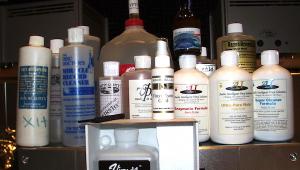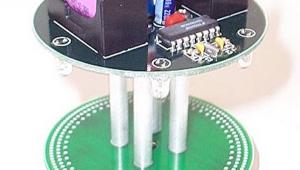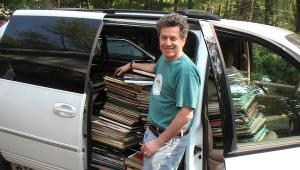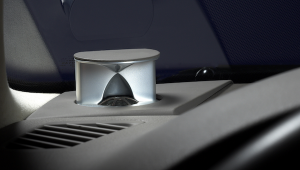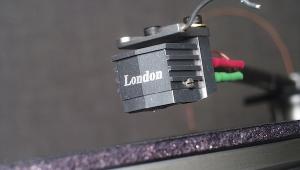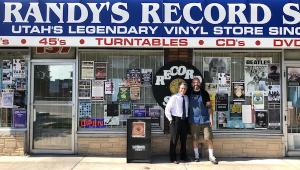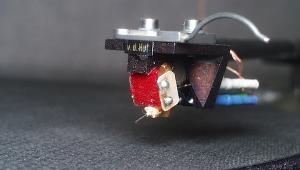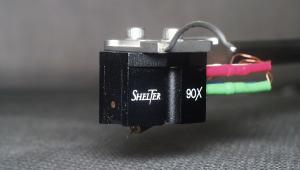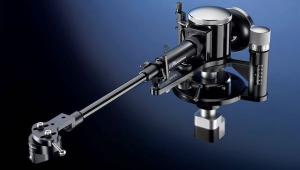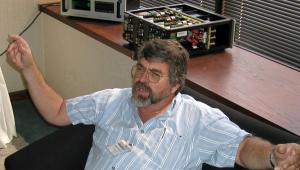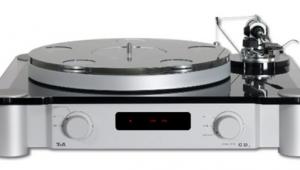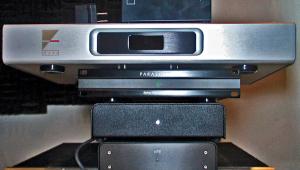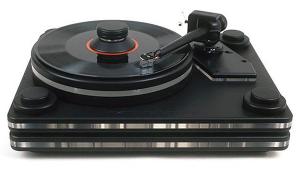Analog Corner #10

(Originally published in Stereophile, May 12th, 1996)
Can't we all get along?" Long before Rodney King, I was posing that question in Los Angeles—in 1983 to be exact. One big difference: I was the one doing the head-bashing. No, I wasn't in an LAPD uniform at the time, though a hyperventilating, mucous-snorting LA cop once did put a revolver to my head. But that's another story.
This story is about collectivism in the age of rack systems. I relate it to you because even though I failed then, I hope to succeed now. If you keep your Stereophiles—which I hope you do—read Ted Lindblad's letter in the January 1996 issue (p.29). Mr. Lindblad, a Connecticut retailer, calls for a high-end marketing collective in response to my observation that high-end audio is an invisible industry in the country leading the charge—the good old U.S. of A!
It is as if Mr. Lindblad had been reading my mind, or thumbing through my filing cabinet to be exact, for back in 1983 I had tried to set up the very sort of cooperative advertising campaign he called for in his letter. This was before I had any involvement in the industry. I was a full-retail–paying, card-carrying audiophile just like you.
Hi-fi in la-la land
I was living in Los Angeles then. Every Sunday I was driven crazy reading the L.A. Times's "Sunday Calendar" section, a thick, tabloid-sized supplement that covered music, film, and the other arts in considerable detail—as you might expect in the entertainment capital of the world. This supplement was filled with display advertising for mid-fi rack systems. Page after page of rack-system advertisements from Federated, Pacific Stereo, and the other mega-chains at the time passed between my fingers, supplemented by co-op advertising dollars supplied by overseas mid-fi manufacturers. Reading the Times, you'd never know L.A. had a thriving high-end audio scene—not by the advertising, and not by the editorial content, which back then was even more neglectful of high-end, high-quality music reproduction than was The New York Times, if you can imagine that.
Also fueling my disgust were the many visits I paid to record-industry executive offices. These were inevitably equipped with a plastic turntable, a low-powered Japanese receiver, and if they were really privileged, a pair of JBL Studio 100s or 4311xes—you know, the ones with the orange or blue foam grilles—-hanging on the wall and wired with lamp cord. This was the typical system used to approve test pressings! No wonder recorded sound was going down the toilet! No wonder these folks were looking forward to CD!
Most of the guys I met in the record biz had never heard of The Abso!ute Sound, or Stereophile, or David Hafler, or Joe Grado, or KEF, or Thorens. And believe me, they, along with tens of thousands of other decision makers, could afford the good stuff—and would probably buy it—if they even knew it existed. But why would they? They read the Times's Calendar section, and rack systems were all that they were seeing in the advertising.
Mikey's solution
What to do? I figured none of the high-end dealers had the financial resources to advertise in the Calendar, and that the only solution was to organize an advertising cooperative. Armed with the Calendar's display advertising rates and some rough estimates for artwork costs from a few of L.A.'s top graphics people, whom I'd met while circulating in the record and film industry, I came up with a proposal that I recently rediscovered:
"A PROPOSAL TO ORGANIZE A HIGH-END AUDIO DEALERS' ADVERTISING COOPERATIVE FOR LOS ANGELES AND ORANGE COUNTY.
"High-end audio retailers do most of their advertising in the 'Hi-Fi Stereo' listing of the L.A. Times's Sunday classified section. It's relatively inexpensive, and most serious audiophiles read it.
"Unfortunately, the other 99.5% of Times readers don't. They do read the 'Home' section, where they see full-page color spreads for $1400 'rack' systems. Worse, they actually go to The Broadway and buy those awful-sounding things.
"They read the Calendar section and see four pages of Federated ads—a company more interested in selling microwave ovens than audio. And more likely than not, they skip over the wordy, postage-stamp–sized ads a few high-end retailers have tried.
"An advertising cooperative would have the financial resources to mount a successful campaign that would put high-end audio in front of all the potential 'rack-system' customers, most of whom don't even know you exist.
"The great popularity of the 'rack' systems, in addition to making a lot of money for department stores and mid-fi chains, is possibly preventing you from getting the kind of financial support your lower-priced 'starter' systems should be providing your business. At the very least, every 'rack' sold is another consumer (and his or her friends) diverted from the high-end marketplace. It's a tremendous loss to all of you.
"A possible theme for a first ad might explain what's wrong with the 'rack,' talking about the importance of the cartridge and the irony of its being totally ignored amidst the flashing lights and gleaming chrome.
"At the bottom of the page all the participating retailers would be listed, utilizing logos, along with addresses and phone numbers.
"Certainly there are many questions to be asked and answered, and details must be worked out, but it would seem that the overwhelming benefits of such an association are self-evident in today's 'upscale,' but all-too-frequently ignorant marketplace.
"If the 'Target Buick Dealers' can get together for their mutual benefit, surely a civilized group of people like high-end audio retailers can too!"
I'll skip over the part where I list my credentials and work experience, but one line worth reprinting here went: "I have been a serious audiophile for most of my life, and hope you'll forgive me for not listing my equipment here, or giving you my 'sign'."
I figured I was doing a good thing, and that I'd be welcomed with open arms everywhere I went, which was to Jonas Miller, Christopher Hansen Limited, Gene Rubin, Shelley's, Optimal Enchantment, Beverly Stereo, Paris Audio, Havens and Hardesty, and the others. I can't remember some of the names, but those of you living in the Basin are probably coming up with them even as you read this—and thinking: "Where'd they all go"? (A few are still around, of course.)
I even took with me a mockup of what I thought was a catchy ad: Over a photo of a prototypical LED-laden, dual-well–cassette–decked, white-woofered rack system, the headline read: "Do You Know Why They Call This a 'Rack' System?" Below, was the copy: "Because it's an instrument of torture! You want knobs and blinking lights? View Mulholland Drive at night in your car. You want a home-audio system that reproduces music? Visit one of the fine retailers listed below."
Nobody's buying
You'd think this campaign would have gone over big in the retail community. You'd think that everyone would realize it was in their self-interest to get the high-end message out to the great unwashed. But No!!!! The little guys didn't want to pay the same as the big guys, and the big guys didn't want to be seen in the same ad as the little guys. "Why would I want to be in the same ad as a little 'pitzela' like Gene Rubin?," an owner of one of the larger stores told me. "Why should I lend him my credibility?"
And the little guys said, "Why should I pay the same as the big guys? They should pay a larger percentage!" No matter what I tried, I couldn't get these guys together. Hey, it was the "go-go '80s"! Everyone was doing well. After all, 20- and 30-somethings who'd grown up with the concept of "hi-fi" and who already owned systems were hip to the tremendous sonic strides being made in high-quality audio gear. They were buying. There were plenty of them and they didn't need selling to. Life was easy!
So what if the High End was losing the low end of the market? There was enough business to go around. Who cared about the future when the now was so good? So what if a generation was being lost to rack systems and big white-woofered speakers?
Audiophile trickle-down theory worked about as well as Reaganomics. The government can borrow money and raise the debt ceiling to cover the shortfall that wasn't supposed to result from slashing taxes without cutting spending (that was the plan), but high-end audio dealers can't. Now look at the Los Angeles high-end audio scene: It's been decimated. There's still plenty of money out there, and the music biz is still there, but high-end audio? The retail pickings are slim compared to 1985. At least the movie moguls are buying high-end video systems, which frequently contain gear made by companies we know and love. But the lost generation is now the married-with-kids, 30-something folks trading up to $400 Dolby Pro Logic receivers and five channels of junk loudspeakers. Isn't that special?
Now I'm not saying my idea would have saved all of those closed businesses, or even any of them. But who knows? Had all of those rack-system buyers, or even a small percentage of them, been steered to high-end audio dealers and had even a smaller percentage of them invested $1400 in a starter music system, perhaps the high-end audio scene in Los Angeles might not be in the sorry state it is today.
What does this have to do with analog?
The past year has seen a resurgence in analog that I think has surprised even its most ardent supporters. No, it is not a mainstream phenomenon, nor will it ever become one, and that's fine. In fact vinyl was at one point in time "mainstream" only because there were no viable alternatives.
After all, as soon as crappy-sounding 8-tracks and cassettes became available, they replaced vinyl for most music lovers, and the CD was originally intended to replace those, not the LP. The vinyl surge we've seen over the past year is simply a "market correction," as they say on Wall Street.
Analog is and will remain a hip, high-cachet, limited-market phenomenon—like fine mechanical watches and real jazz and classical music. Turntables, not CD players, get featured in television commercials and films like Indecent Proposal (a VPI TNT). Have you seen that recent General Foods International Coffee ad where the woman comes home from a hard day at the office and puts on a record? Did you notice the 'table? Not a Technics or Kenwood, but a vintage wooden Grado Lab arm on what looks like an old Rek-O-Kut! This wasn't an accident. The art director or the commercial's director chose that—and it wasn't product placement for profit. It was probably product placement for passion.
On the other hand, perhaps a boycott of Ray-O-Vac batteries is in order, given the Michael Jordan ad where he talks about "progress" and "not being left behind by technology," backed by the image of an LP record fading to a CD.
It's now or never
In any case, now is the time for the analog community to get together and encourage and promote the phenomenon. According to the February 26 issue of Audio Week, the RIAA reported that vinyl LP and EP sales in 1995 were up 41% over 1994. Okay, total volume was a meager 2.2 million unit sales, or $25 million in sales, versus 727.6 million units for full-length CDs worth billions of dollars. However, the increase in CD sales of 11% over 1994 represents the smallest increase in CD growth since the introduction of the medium. And let's face it: The percentage of actual new LP sales that get reported to SoundScan is probably fairly low, so I'm sure LP sales were much higher than reported.
With the hipness and commercial success of retro "bachelor-pad" and "exotica" music, what better to play such recordings on than a retro-looking high-end audio system? It's a natural tie-in. But will we see industry "lifestyle" ads in Rolling Stone or Spin promoting neat-looking high-end audio systems over plastic "mini-systems''—the rack-system replacement? Alas, probably not. And will we see the analog community present a united front to the world? Will we see Eddie Vedder or Slash endorsing vinyl? Probably not, and that's too bad, because despite the increase in vinyl and turntable sales, last year was a mixed bag of ups and downs that leave this industry observer a little queasy.
MCA issued its first five "Heavy Vinyl" titles, but they were its last five, too. As I reported here recently, they've killed the project. Blue Note stopped pressing its Connoisseur Series jazz reissues on vinyl (though the SBM CDs will continue), and GRP has discontinued pressing its outstanding Impulse! reissue series on vinyl. That's not good. What is good is the apparent willingness of label executives to license catalog to the audiophile vinyl labels, which will probably do a better job anyway.
Retail sales of these reissue LPs failed to meet label expectations. Why? Expectations were too high for one thing, and retailers weren't buying for another. You can't sell the records if they're not on the shelves. The MCA "Heavy Vinyl" series had my name (and Stereophile's and The Tracking Angle's) on a cover sticker that I never had the satisfaction of seeing on a retail store shelf—and believe me, I looked !
My local Tower did a half-assed job of stocking the Impulse vinyl. They sold out every piece I ever saw them put up, but did they restock? No. So fine, we can forget about depending on all but a handful of mostly independent retailers to find out what's available on vinyl. Tell the average consumer about records and what do they say? "I didn't even know they were making them anymore." "Can you still buy a turntable?" "I can't find a needle for mine!" You've heard it, I'm Shure.
Even I can't find a reliable source of information as to what's available on vinyl. The record company publicity folks don't even know—vinyl is like some kind of back-door deal at the record labels. What I'm about to try is compiling a list of all the active commercial pressing plants nationwide (there probably aren't that many), and getting a source at each one to provide me with a list every month of what's being pressed.
What we need is an analog clearing house and an analog publicity push. (And when I say "we," I mean the industry and the consumer.) Remember in the late '70s when the record industry had that "Records are your best entertainment value" publicity campaign going? That's what analog needs now.
Instead, we're getting paranoia and ego trips. There's animosity and pettiness among the audiophile labels like you wouldn't believe, but don't expect me to air the dirty laundry here. And there's no reason for it! Are these companies really in competition when they all reissue different titles? Sure, there's competition to license titles, but clearly there are enough good recordings worth reissuing to last a lifetime—and enough bad ones too, judging by some of the choices. But instead of cooperating, they fight among themselves.
The more vinyl that's available, the more viable the format becomes for everyone. Same goes for hardware. There's got to be room for more than two or three high-quality tonearms; otherwise we're fooling ourselves to think there's a future in all of this. Yet figurative elbows fly when someone new tries to enter the field. I guess it's easy to sit back in Journalism Land and write these words, but I really do believe the more the market opens up, the more choices consumers have, and the more sales will increase. It's not a zero-sum game, guys!
So, what's needed is an Analog Association—a coalition of hardware and software manufacturers working together for the common good.
Imagine if the catalogs of Classic, DCC, Mobile Fidelity, Speakers Corner, Reference Recordings, Clarity, Cisco, Alto, Analog Productions, the major labels, and the rest of the analog offerings—even the used-LP dealers—were combined into one printed analog compilation.
Imagine if all of the currently available analog hardware products were assembled in one large photo shoot—all the arms, turntables, phono sections, cartridges and accessories—not forgetting products from Technics, Denon, Kenwood, and the other more mainstream companies that still support the old technology—and tastefully photographed for a co-op advertisement aimed at young, hip music lovers, or for a public relations foray.
How about a campaign featuring endorsements from musicians like Eddie Vedder or Bob Dylan or Branford Marsalis or Keith Jarrett, or engineers like Steve Albini, Joe Ferla, or Shawn Murphy, saying "I still like vinyl!" You could add photos of record company execs (wearing masks, of course) who confide—off the record, of course—that they prefer listening to vinyl at home, too. You wouldn't believe how many of those people there are! Well, maybe you would.
All such ads would be paid for by contributions from the hardware and software manufacturers. What a shock to the average Rolling Stone and Spin readers such an ad would be! How about it folks?
